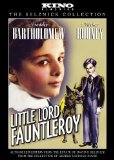| Reviews & Columns |
|
Reviews DVD TV on DVD Blu-ray 4K UHD International DVDs In Theaters Reviews by Studio Video Games Features Collector Series DVDs Easter Egg Database Interviews DVD Talk Radio Feature Articles Columns Anime Talk DVD Savant Horror DVDs The M.O.D. Squad Art House HD Talk Silent DVD
|
DVD Talk Forum |
|
|
| Resources |
|
DVD Price Search Customer Service #'s RCE Info Links |
|
Columns
|
|
|
Little Lord Fauntleroy (Kino Classics Remastered Edition)
Still the best version of this classic tale. As part of their Selznick Collection, Kino Classics has released Little Lord Fauntleroy, the 1936 David O. Selznick-produced family drama based on the 1886 novel by Frances Hodgson Burnett, directed by John Cromwell (yeah right) and starring Delores Costello, C. Aubrey Smith, Mickey Rooney, Guy Kibbee, Henry Stephenson, E.E. Clive, and in the title role, wonderful little Freddie Bartholomew. Mastered in HD, according to the DVD back cover, from "an original nitrate 35mm print, preserved by the George Eastman House Motion Picture Department," this is probably the best-looking copy of Little Lord Fauntleroy I've ever seen (considering the dubious nature of most public domain versions out there). No extras, but content is a must for anyone looking for perfect family entertainment.
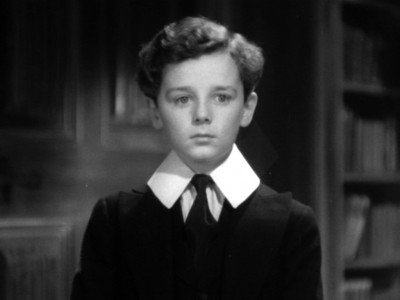
Brooklyn, New York, 1885. On a quiet backstreet, young Cedric "Ceddie" Errol (Freddie Bartholomew) loses his father to illness. His mother, beautiful "Dearest" Errol (Dolores Costello), is devoted to making the polite boy happy―a task that's made easier by the caring friends Ceddie has around the neighborhood. Poor apple seller Mrs. McGillicudy (Jessie Ralph) always has a smile and the best apple for the boy. Grocer Silas Hobbs (Guy Kibbee) thinks that despite Ceddie's pronounced English accent―as an American, Hobbs has no use for English aristocracy―the conscientious, caring little boy would be a credit to the grocery business. And best friend Dick Tipton (Mickey Rooney), a bootblack, will gladly slug it out alongside Ceddie whenever the neighborhood toughs decide to razz Ceddie over his polite manners and "odd" accent. Into this poor but happy extended "family" comes Mr. Havisham (Henry Stephenson), an English lawyer sent over by the Earl of Dorincourt (C. Aubrey Smith) with some shocking news for young Ceddie: after the death of his father, Ceddie is now the rightful heir to the family fortune and the new "Lord Fauntleroy." He is to go over to England and assume his ancestral position, and his mother may accompany him...but she will not live with him at Dorincourt Castle. Apparently, the Earl still holds deep prejudices against Americans, and years before, it mortified him that his beloved son would marry the American Dearest, so she may stay at the nearby lodge, and even have an allowance...but the Earl will henceforth raise young Ceddie. This arrangement breaks Dearest's heart, but she agrees to it to give her son a better life; so selfless is she that she doesn't even mention to Ceddie the Earl's punitive, cruel restrictions. In fact, she tells Ceddie that the Earl is an exceedingly compassionate man and a great benefactor to the tenants on his land, which of course is not true and which of course, the innately benevolent, gentle Ceddie believes instantly. Will the Earl change his ways to meet that undeserved love of Ceddie's? And will Ceddie actually become the new "Lord Fauntleroy"...or will intrigue cause his downfall?
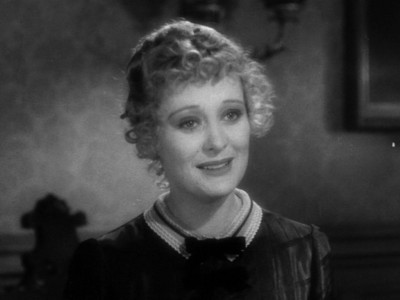
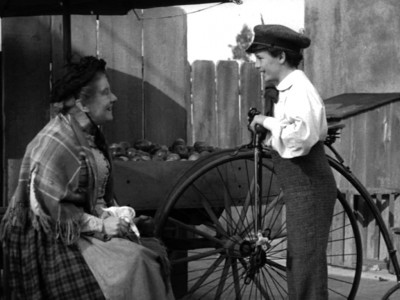
According to the sources I've read, Little Lord Fauntleroy was former Metro-Goldwyn-Mayer producer David O. Selznick's first independent production under his own Selznick International Pictures studio banner for one reason only: it was all set to roll before the cameras at M-G-M, prior to his departure. Selznick had shepherded the project through the pre-production phase, and simply bought out the entire development from M-G-M as a way to quickly put a worry-free-yet-still-prestigious movie with his name on it into the theaters (through releasing studio United Artists), helping to establish his studio as a "player" while he slowly solidified plans for new projects (he also brought over The Garden of Allah, another quick hit for the studio at the end of 1936). If you didn't see the Selznick International Pictures credit at the head of the film, you'd swear Little Lord Fauntleroy had to be a Metro 30s' classic, such is Selznick's attention to glossy detail and warm sentiment here, as well as a measured, self-assured tempo and atmosphere that was so closely associated with the "Tiffany's" of the major Hollywood studios, as adopted by Selznick when he moved from RKO back to Metro in 1933 to helm his own unit production team next to fellow wunderkind Irving Thalberg.
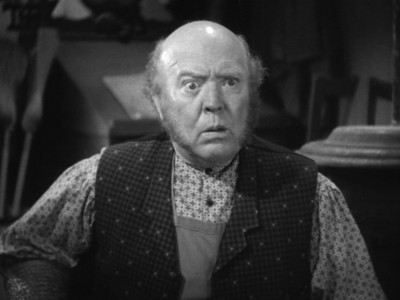
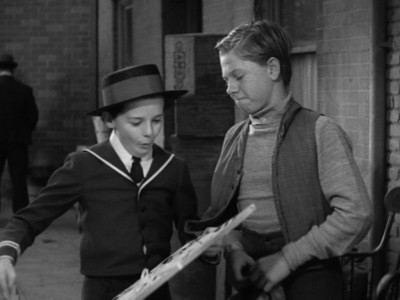
And according to almost everything ever written about David O. Selznick, it's also fair to assume that Little Lord Fauntleroy is indeed a "David O. Selznick picture" more than a "John Cromwell picture," due to Selznick's meticulous (read: "obsessive") oversight of every single aspect of his own productions. I don't think it had got to the point yet in Little Lord Fauntleroy where Selznick demanded that even light changes and camera set-ups on the set during filming be pre-approved by him, often overriding suggestions of whatever director was assigned that particular project, but clearly Selznick controlled every aspect of Little Lord Fauntleroy's pre-, production proper, and post-production phases (particularly the editing), so it's his movie all the way. To note that Little Lord Fauntleroy's scripter was none other than Hugh Walpole probably elicits an, "Um...who?" from anyone but an English Lit. professor, but even the presence of such a writer of Walpole's stature (a best-selling author and contemporary of Woolf, Conrad and James, he had previously scripted Selzinck's 1935 M-G-M smash, David Copperfield, also starring Bartholomew) doesn't alter the fact that Selznick exercised line-by-line control of his scripts, while often writing and re-writing (and re-writing...) large portions himself (as well, Selznick was notorious for not wanting to change anything in a cinematic adaptation of a literary classic or bestseller; he felt that if the literary property was popular and successful, than it should be strictly adhered to in movie terms).
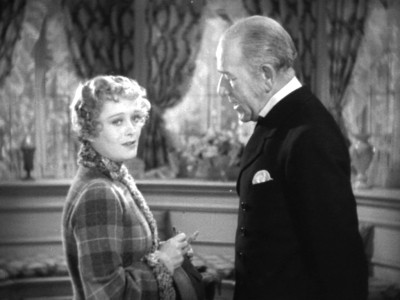
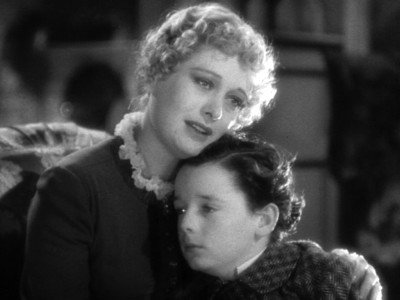
All of which means absolutely nothing to a family sitting down today to watch Little Lord Fauntleroy. I've seen a couple of other movie versions of the story (Mary Pickford's silent version is amazing just from a technical aspect, where she plays both Ceddie and Dearest, while Ricky Schroder's 1980 is amazingly inept and superficial), but this 1936 version is still superior in terms of overall proficiency of the moviemaking, and in the depth of genuine feeling Selznick and his team are able to render from this fanciful tale. I would imagine if you take the term "sentimental" as a pejorative, you won't find Little Lord Fauntleroy to your liking, but its heart-tugging manipulations, while calculated to be sure, have a quiet, tender sincerity about them (aided by Selznick's superior craftsmanship) that's remarkable, regardless of premeditation. There's a pinpoint accuracy to the production―in the lavish sets, in the careful production design, in fluid, effortless editing rhythms and the measured tempo of the individuals scenes―that denotes a project lovingly cared for in spite of (or perhaps more accurately, because of) the producer's fanatical attention to detail. There's an effortlessness to how Little Lord Fauntleroy carries you from scene to scene, and from emotion to emotion, that can only occur from the most serious, strenuous work on the part of the production team that it seems invisible, such is its success. But of course we know it's not. When Selznick/Cromwell shows Dearest putting a lighted candle in the window for Ceddie, it breaks our heart...only to have it mended again when we cut to the Earl's servants laughing delightedly at the sight of the once-frightening Earl, down on all fours, shooting marbles with the adorable Ceddie.
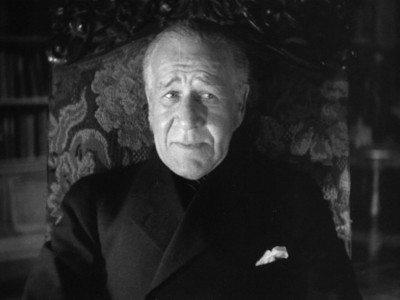
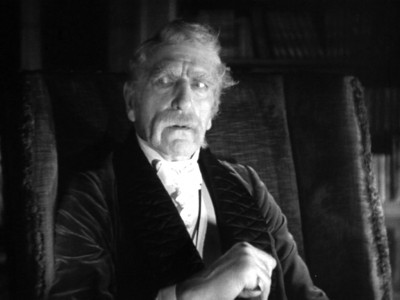
Little Lord Fauntleroy is filled with such ebbs and flows of emotion, never becoming maudlin or sticky sweet, always keeping just the barest, slyest sense of humor about the corners of its storyline (Kibbee especially, stealing every scene he's in), while constantly going back to a baseline of gentle kindness and emotion that's remarkably tranquil. When the crusty Earl, all prepared to hate Ceddie, is taken aback at how sincere and engaging the little boy is, Selznick and his team don't hit us over the head with sentiment; they slowly build up the relationship with beautifully realized vignettes that charm us, and they do this with small, seemingly unremarkable details that speak volumes (who doesn't get choked up a bit when the gout-ridden Earl looks at his new grandson in wonder when Ceddie sweetly asks, "Would you like to lean on me?" as they walk out of the room?). That careful attention to small details extends to the performances as well (Selznick controlled this aspect, too, requiring extensive retakes from his directors if he felt a scene wasn't playing right). Watch Stephenson and Smith in their first exchange as Stephenson feels out the degree of intolerance Smith has for the boy; it's a masterpiece class in acting, going from broad (Smith's outsized, delightful harrumphing), to Stephenson's beautifully subtle reactions. All of this is anchored by Bartholomew's turn, and he doesn't hit a wrong note in the whole picture. There are times when he does come over as slightly "stagy," but that's merely a function of the melodramatic framework; those moments serve as effective counterpoints to when he's believably overcome with his emotions, both sad and happy ones. It's a noteworthy performance from a child actor, one that, if it were missing here, couldn't have saved Little Lord Fauntleroy despite all of Selznick's careful planning.
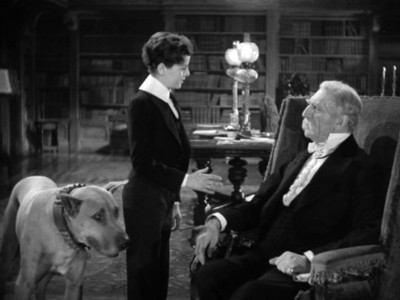
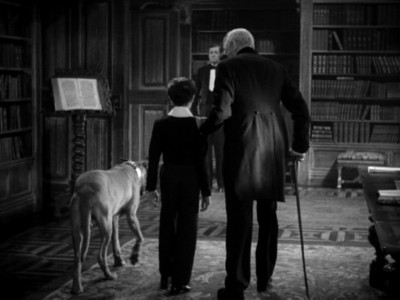
The DVD:
The Video:
The full-frame, 1.37:1 black and white transfer for Little Lord Fauntleroy looks quite good, with okay blacks, a generally consistent contrast level and sharp image, and the expected screen scratches and dirt (considering this doesn't look digitally scrubbed).
The Audio:
The English mono audio track was serviceable, with expected hiss, and no subtitles or closed-captions options.
The Extras:
Trailers for Nothing Sacred, A Star is Born, and Pandora and the Flying Dutchman are included.
Final Thoughts:
Beautiful family entertainment. Still the best movie version of this timeless tale, producer David O. Selznick's Little Lord Fauntleroy works for viewers today not because it isn't manipulative or fanciful...but because it is, and done so with an innate sincerity that's unmistakable and often times, moving. I'm highly, highly recommending Little Lord Fauntleroy.
Paul Mavis is an internationally published movie and television historian, a member of the Online Film Critics Society, and the author of The Espionage Filmography.


|
| Popular Reviews |
| Sponsored Links |
|
|
| Sponsored Links |
|
|
| Release List | Reviews | Shop | Newsletter | Forum | DVD Giveaways | Blu-Ray | Advertise |
|
Copyright 2024 DVDTalk.com All Rights Reserved. Legal Info, Privacy Policy, Terms of Use,
Manage Preferences,
Your Privacy Choices | |||||||









